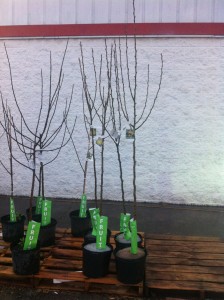“What do I look for in a tree?” you ask. It can be overwhelming, walking into a garden center in spring or fall. There are so many choices and qualities found in trees.
Here are five guidelines to purchasing a healthy valuable tree.
1. Does it have a central leader? This is very important for oaks, hickories, etc. that grow large and provide shade. Why is the central leader so important? The central leader guides the growth of the plant upward and the single stem is resilient to damage from wind and pests. Central leader is less important for fruit trees and flowering trees like dogwood and ornamental cherry. I believe a strong central leader is very important for evergreen trees.
2. How does the container root area look or the burlapped area? If roots are growing out of the container or the burlap is tattered, consider passing on this particular tree. Unless you are buying the tree at a discount price. I call these plants “tired.” They have been sitting at the retail lot for too long and need a home. Negotiate a discount if you like or simply pass for a fresher, younger tree.
3. What does the plant tag say? If the tree is missing an ID tag, search Google for info on mature size and spacing like “white oak mature size”. Don’t buy an oak tree if you want something for a small space.
For the best fruit tree in your area, search your local state university extension website for articles. On Google, search “best apple tree for home garden in TN.”
4. Are you budget conscious? Smaller plants typically cost less money because they are younger. Look for small trees if you’re on a tight budget and are willing to wait a few years. Smaller plants also need less daily care.
5. Know the difference between evergreen and deciduous. If you need shade in the hot summer, plant a deciduous tree. If you want to screen for privacy or concealment, plant an evergreen tree.
How has your experience been at the garden center buying tree? Please answer in the comments below.





